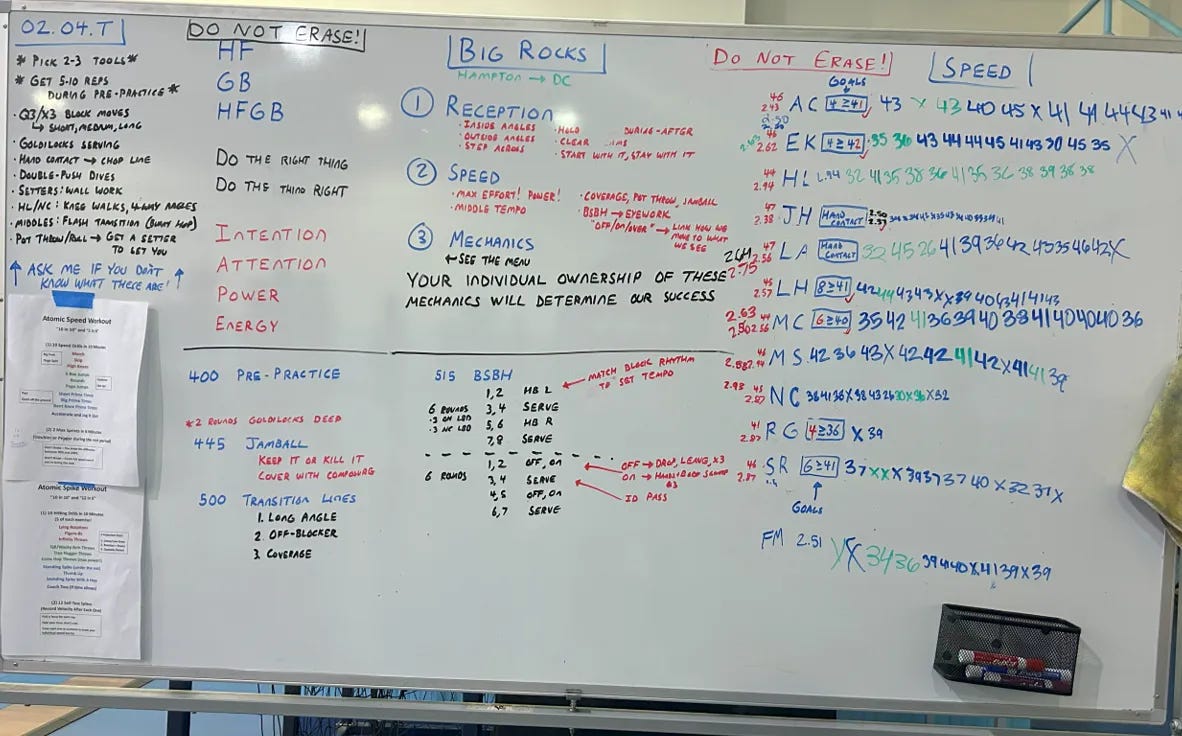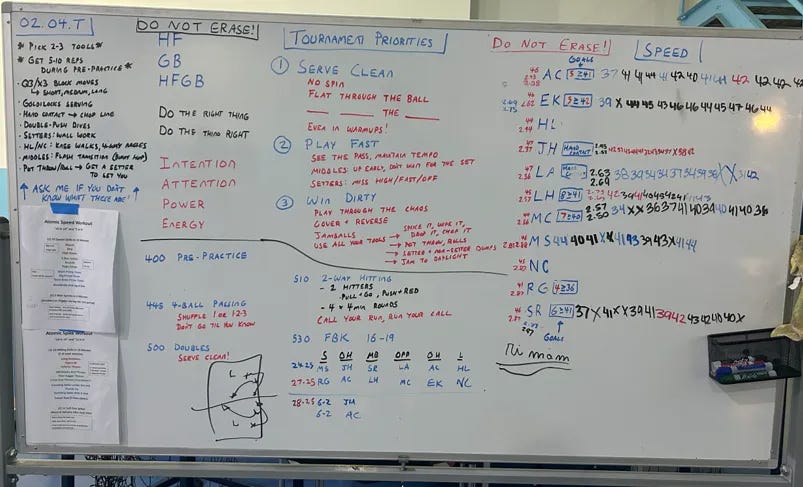If you’re here for more NCAA Analysis, I have the next part coming out on Friday. Stay tuned for that. But even if you’re not in the club world, this review discusses a lot of how I look at my serving and passing, which applies to any coaching situation.
Most of you reading this were either coaching or recruiting this past weekend at a multi-day President’s Day tournament. Earlier this season, I shared some of the specific statistical information I look at after a tournament. For those of you who are coaching at a higher level than club, it’s going to be very similar to my post-match analysis at those levels, just not quite as granular. Read the article if you want more details, but to put it simply: I’m not a huge believer in recording a lot of statistical data in-match while I’m coaching club. I think there’s too much teaching that needs to happen and you can’t be looking down at a stat sheet the whole time.
So let’s run down the stats and then get to some other stuff:
Triangle Statistics
Point and Sideout Differential
344 - Our Points
326 - Opponent Points
56% - Our Sideout
54% - Opponent Sideout
47% - Our Earned Sideout
48% - Opponent Earned Sideout
I included both overall Sideout and Earned Sideout to highlight a bit of a separation there.
We had a 2% Sideout advantage over our opponents, but our Earned Sideout was 1% lower. How could that happen? If you said: “we missed fewer serves,” you’re right!
Terminal Serving (+31, 59%)
99 - Us
68 - Opponents
First Ball (-8, 48%)
119 - Us
127 - Opponents
Transition (-5, 49%)
126 - Us
131 - Opponents
We played 15 set-equivalents of volleyball (if you count 3rd sets as 0.5), so we gave up a little less than 1 point per set when the ball was “live” (First Ball + Transition) but we gained back 2 points per set with our Terminal Serving advantage. Let’s dive into that a little more.
Terminal Serving Aspects
40 - Our Aces
34 - Opponent Aces
34 - Our Serve Errors
59 - Opponent Serve Errors
We allowed fewer aces than our opponents and missed a lot fewer serves in order to do so. If you’ve been following the In The Gym section you’ll know that our #1 priority in training has been reception, with a significant sub-focus on serving mechanics, particularly introducing a bunch of Goldilocks Serving to focus on hand contact quality.
And then our number-1 Tournament Priority was to Serve Clean.
In terms of reception, we did allow fewer aces than our opponents, so we won the Aceball battle for the tournament as a whole. In the three matches we lost, we actually did allow more aces than our opponents, although at the cost of them serving significantly more errors. More on that below.
2-2-2
I’ve talked about this before, but a good rule of thumb for good but sub-elite volleyball is the 2-2-2 rule.
Serve 2 or more aces per set. While missing 2 or fewer serves. And give up 2 or fewer aces.
Even for most NCAA programs, this isn’t too far off the ballpark. At the highest levels of NCAA Women (and pro, etc), the ace environment is lower, so you’re not going to average 2 aces per set. And if you’re allowing a full 2 aces per set, you’re going to struggle to win the Big 10, for example. And also, at the elite levels, men’s and women’s volleyball diverges in terms of error rate, etc.
But for hs/club and even smaller-school collegiate programs, the 2-2-2 rule is a pretty good guide. We’ve seen that the highest level of club play generally matches it. So how did we do on the 2-2-2 rule? We played 7 matches, two of which went to 3, so that’s 16 sets total. But in terms of the 2-2-2 rule, you treat your 15-point sets as being 1/2 of a set, so I’ll divide our raws by 15, instead of 16.
Per-Set, “2-2-2” Standards
2.7 Aces
2.3 Serve Errors
2.3 Aces Allowed
So… we’re getting in the ballpark. Going into this tournament, we were at:
2.1 Aces
2.2 Serve Errors
2.6 Aces Allowed
I would say the level of competition was pretty in-line, so we allowed fewer aces and served more aces, while keeping errors the same. (0.1 more per set, but we actually served in at a slightly higher rate, because this tournament our Point % was higher than our season average, which means we did slightly more serving overall.)
In terms of the Aceball game, a small but important step forward for our team, so I feel good about accomplishing that. Our Good Pass % was slightly higher (43% this weekend, compared to 41% previously), but not in a way that would meaningfully affect the outcome of matches. So still some work to be done there. With our level of physicality (only one kid over 5’10”), we probably need to be at or above 50% In-System to meaningfully compete in Open.
Analyzing Losses
One thing that I also like to do is look at our losses.
Keep reading with a 7-day free trial
Subscribe to Smarter Volley by Joe Trinsey to keep reading this post and get 7 days of free access to the full post archives.




